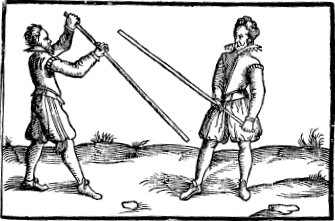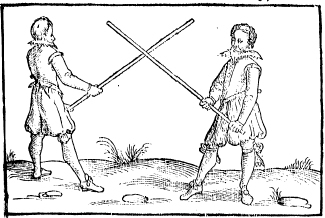Study
Guide for the Staffe Play of Joseph Swetnam's
Schoole of the Noble and Worthy Science of Defence
By
Stacy Clifford ©2017
Swetnam's staff section is generally less organized than his single
sword section, with few headings and scattered references to fundamentals.
The
outline below is my attempt to organize Swetnam's instruction on
staff for quicker reference and study ("Cliff Notes," if you will).
Grip
Swetnam's illustrations show the staff gripped with one hand at the rear
tip of the staff palm down and one hand one-quarter of the way up, with
the palm up when in the low guard (an over-under grip), and the hands
remain in the same positions in the high guard. In the comments on changing
grips, the "weaver's shuttle" method implies a double-overhand
grip with both palms facing downwards.


Guards
- Low guard - Hands at waist, point up, with the tip leaning
to the outside (left if you lead with your left hand)
- High guard - Hands at or above the head, point hanging down
to the outside.
Other guards mentioned (not to be used):
- Hands at waist level, point on ground (equivalent to German alber)
- not recommended due to vulnerability to falsing and thrusts.
- With the long-staffe or pike, hands at head level or higher with the
point on the ground, sometimes using the foot to help lift the point
for a thrust. "...he that useth this guard, must be strong,
and verie active, and nimble..."
Staff Length
When in the low guard a staff of any length may be used, but if you use
the high guard, keep the length of your staff to eight feet or shorter
so that your point will clear the ground when defending against a thrust.
Swetnam mentions that the low guard works well with "the Quarter-staffe
of seaven or eight foot, or for the Long-staffe of twelve foote, and for
the Pike of eighteene foote."
Footwork
Simple steps with the front foot advancing and retreating, according
to Swetnam. Only pass forward with the rear foot if thrusting against
a longer weapon, and pass back to change grips on the staff.
Basic Strikes
- Thrusting double - thrust with both hands on the staff (term
borrowed from George Silver).
- Thrusting single - let go with the forward hand and propel
the staff forward with the rear hand, then "pluck back" into
guard (Swetnam's favorite attack).
- Slip Thrust - a combination of the first two, where both hands
remain on the staff, but it slides through the forward hand until both
hands meet at the butt of the staff.
Blows
- Vertical (mentioned but never defined)
- Diagonal falling (mentioned but never defined)
- Advice - Swetnam maintains that you should never raise your
point to strike a blow because you make yourself vulnerable to the thrust.
Changing Grips
Swetnam emphasizes the importance of being able to fight with your staff
from either side of your body, and to match your opponent if he switches
his lead hand and foot to remain in your forehand defense (see below).
When in the high guard, slide your front hand first toward the far end
of the staff, following it with your back hand - "like a Weaver's
shuttle" - while passing back with a step, thus changing the
staff to the opposite side of your body. A weaver's shuttle is operated
on a loom with both palms facing downwards, implying a double-overhand
grip. Swetnam does not put forth any grip change method from the low guard
or for an over-under grip, though various methods may be devised.
Forehand Defense
Forehand Defense - "leave all your bodie open, so that
your enemie cannot endanger you on the out-side of your staffe,"
and always bear blows and thrusts toward the inside of your staff (if
your right hand is forward, toward your left and vice versa), for "you
may defend twentie thrusts or blowes before hand, better than one backward…"
Low Guard Defenses
- Above the waist - Strike and thrust defenses are the same -
counterstrike the weapon aside early before the blow achieves full force,
then thrust.
- Below the waist - Turn the point down to meet the blow or thrust
and strike it aside, then turn the point back up to thrust.
High Guard Defenses
- Strike Defense 1 - Raise up and strike the blow away early
as before, then thrust. Works best against an attack made with point
down also, but may work against strikes from low guard if intercepted
while the point is still raised up.
- Strike Defense 2 - Pitch the point of the staff into the ground
wide of the body (about 45 degrees) on the side to be defended and release
the forward (lower) hand to protect the knuckles, let the blow strike
the staff, then pluck it back up into your guard with both hands again.
Though it is not mentioned, stepping offline away from the blow is helpful
in pitching the point of the staff out wide enough for a proper defense.
- Thrust Defense - Bear the staff across your body and sweep
the thrust aside like a broom. More dangerous than defending a thrust
from the low guard defense because the distance between the staff and
the body is shorter and there is less time to defend.
False Plays
Note: Despite his own advice never to strike a blow, Swetnam shows
a couple of striking attacks and feints here. These are presumably for
use against the unskilled fighter who would not know to counter all blows
with a thrust. Names of plays below are my own shorthand except for the
one shown in italics.
- Simple Disengage - Throw a false blow or thrust at your opponent
wide to his outside, but convincing enough to force him to defend it.
When he goes to strike it aside, duck your point under his hands and
come up to thrust on the other side. Don't let him make contact with
your staff at any point or the falsing will be disrupted.
- Defense - Keep your parries narrow and not wide - you only
need to move one foot or less to defend your body safely. If you
see him dropping his point, you can also drop your point to counter
it - remember to defend forehand above and below.
- Double-Overhand - Raise up as if to make a strong vertical
blow at your opponent's hands or head, then check the blow as he goes
to defend it strongly and let him pass by, then hit him with a second
blow.
- "A Slippe at a Staffe" - If your opponent
throws a blow at you when you are at the edge of his range, draw back
your head, body and staff to let the blow pass by, making sure your
staff is close upright by your side to defend you, and strike him after
his blow goes past.
- Blow Fades to Thrust - Make as if to strike a strong downright
blow at your opponent's head, "fetching him with a great compasse,"
then draw back your hands as the blow comes down and try to make his
parry attempt miss, then turn the blow into a thrust.
- Defense - If your opponent offers any type of blow, thrust
single at him when he raises his point to strike.
- Low-High Thrust - Throw a false thrust at your opponent's lower
leg or foot. If he turns down his point to defend it, turn your point
back up and thrust high before he can reverse his defense.
- Defense - Pluck up your forward foot off the ground and
counterthrust high with a forward lunge as he thrusts low. It is
better to leave your staff guarding your upper parts "which
are the killing places" rather than to defend your legs.
Closing Maneuvers
- Defending a blow when attacked at night - Go into your high
guard with your hands spread wide apart to take the blow between the
hands, then close in and turn the butt end of the staff around to hit
him in the breast or face.
- Against a longer staff - Thrust single at your opponent's face
with a pass forward, then pass forward again as he defends it to grab
your staff in high guard and carry his point over your head, after which
you can strike him with your butt end, trip him, or grapple him.
- If you have a bill or hook or other bladed polearm, you can fall
away (pass back) from the high guard at the half-close and rake
the blade across the opponent's legs, keeping the butt of your weapon
high to defend your head.
Staff vs. Sword & Dagger
Against an opponent armed with a sword & dagger or rapier & dagger,
remain in the low guard with your point lowered to aim at the opponent's
breast. Do not strike a blow because he may defend it with both weapons
crossed (castle guard) from below and run in underneath the staff. When
thrusting, keep both hands on the staff so that you may recover and thrust
again more quickly to keep him at a distance. If he strikes at the point
of your staff to cut it off, "slippe" it by dropping
the point to make him miss, then follow immediately with a thrust.
Staff vs. Other Polearms
A staff with a pike on the end has the advantage over "the Welch-hooke,
Holbert, Partizan, or Gleave" if equally matched in length. It's
worth bringing a hatchet with you into the field to cut a longer staff
if fighting a duel. Headed weapons tend to over-swing due to the extra
weight at the end, and are therefore vulnerable to the nimble false play
of the quarterstaff. Attack by making a false thrust to one side of his
weapon and then follow it up with a true thrust on the opposite side.
If the opponent strikes a blow against your low guard, slip the blow by
dropping the point or lifting it up and then answer with a thrust. High
guard defends blows strongly, but is slower to defend against a thrust
than the low guard.
See
Also:
The
Schoole of the Noble and Worthy Science of Defence
(Modernized transcription by David Kite)
Joseph
Swetnam - Biographical Sketch
Advice
and Ethics in Joseph Swetnam's Schoole of Defence
Study
Guide for the Single Sword Play of Joseph Swetnam's Schoole of the
Noble and Worthy Science of Defence
|

